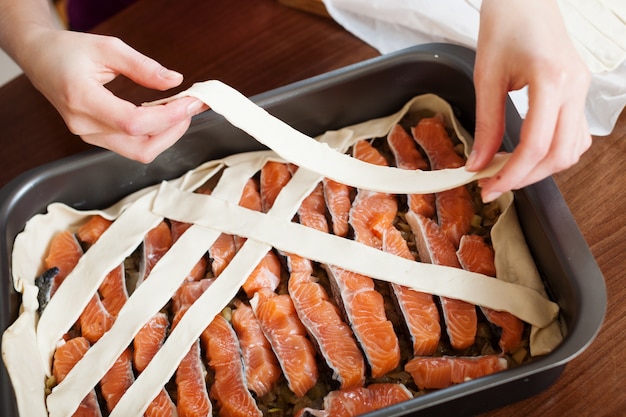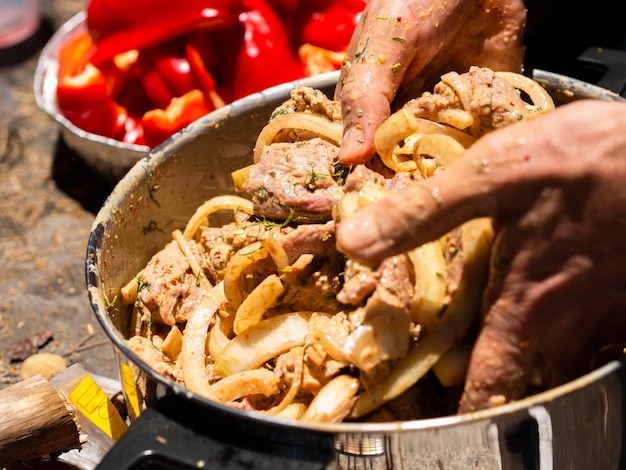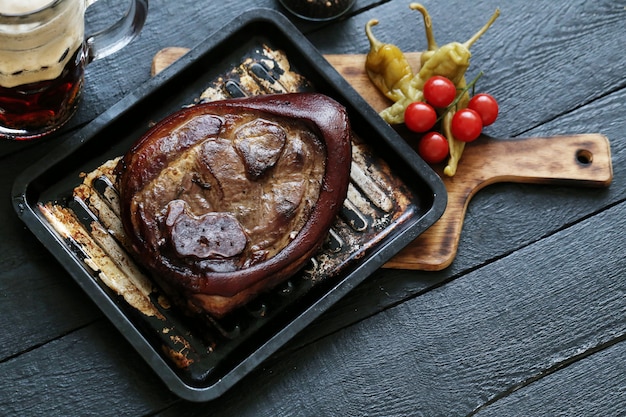There’s nothing quite like the comforting aroma of slow-cooked pork tenderloin filling your home. It's a dish that whispers "cozy" and "delicious," urging you to settle in for a relaxed evening with a plate of melt-in-your-mouth meat. But achieving that perfect, tender, juicy result can feel like navigating a culinary maze. Too long in the crock pot, and you risk dry, stringy meat resembling a piece of rubber. Too short, and you're left with undercooked pork – not a safe or appealing outcome. Fear not, my friends! I'm here to guide you through the labyrinth of slow-cooked pork tenderloin, armed with tips and tricks to create the ultimate masterpiece.
I’ve been a kitchen enthusiast for years, and trust me, I've experienced my fair share of Crock Pot disasters. From succulent and flavorful to dry and disappointing, I've done it all. But through trial and error, I've cracked the code. Now, I'm confident enough to share my secrets with you, guaranteeing you'll be creating pork tenderloin that'll have your family begging for more.
(Part 1) Selecting the perfect pork tenderloin: The Foundation of Flavor

A delicious Crock Pot pork tenderloin starts with choosing the right cut of meat. You want a pork tenderloin that's lean and free of excess fat, ensuring a tender and flavorful result. You'll find them in the meat department of your local supermarket or butcher shop.
1.1. The Look and Feel of a Quality Tenderloin
Take a good look at the tenderloin - it should be firm to the touch, with a pale pink hue. Avoid any tenderloins that have a dull grey color or feel slimy, as these are signs that the meat may not be fresh. Think of it like choosing a ripe peach - you want one that feels firm and has a healthy color.
1.2. Size Matters: Finding the Right Fit
When it comes to Crock Pot pork tenderloin, size definitely matters. A tenderloin that's too large might not cook evenly, leaving you with undercooked portions and dry, overcooked parts. I usually opt for a tenderloin that's between 1 and 1.5 pounds. This size is ideal for a family of four or a cozy dinner for two.
1.3. The Power of Trimming: Cleaning Up the Canvas
Before you get started, take a few minutes to trim any excess fat from the pork tenderloin. This isn't about removing all the fat; it's about trimming any large pieces that might hinder the cooking process. Trimming the fat helps to prevent the tenderloin from becoming overly greasy and adds to a more pleasing aesthetic. It’s like cleaning your canvas before starting a painting - a smooth surface leads to a better final product.
1.4. Don't Be Afraid to Ask: The Butcher's Expertise
Don't be shy! If you're unsure about choosing the right tenderloin, don't hesitate to ask the butcher for help. They're the experts, after all, and they can point you in the right direction. They’re usually more than happy to help and offer advice, guiding you through the selection process. It’s like having a personal stylist for your pork - they’ll help you find the perfect match for your culinary needs.
(Part 2) Seasoning the Pork Tenderloin: A Symphony of Flavors

You've got the perfect pork tenderloin; now it's time to get creative with the seasonings! This is where you can unleash your inner culinary artist and create a masterpiece that'll tantalize your taste buds. Think of it as adding the perfect notes to a symphony, each spice contributing to the overall harmony of flavors.
2.1. The Classics Never Fail: Building a Solid Foundation
For a classic and crowd-pleasing flavor, I usually start with a simple mix of salt, pepper, and garlic powder. These are the building blocks of flavor, adding a subtle depth and enhancing the natural sweetness of the pork. It’s like the foundation of a house - you need a strong base to build upon.
2.2. Adding a Punch of Flavor: The Spice Rack Symphony
To kick things up a notch, experiment with a blend of herbs like rosemary, thyme, and sage. These herbs add a lovely aroma and a touch of earthy complexity to your dish. Don’t be afraid to get adventurous and try a dash of paprika for a hint of smokiness or even a pinch of cayenne pepper for a subtle kick. It’s like adding different instruments to your symphony - each spice brings a unique texture and tone to the flavor profile.
2.3. Don't Forget the dry rub: Creating a Flavorful Crust
For a truly delicious crust, I recommend using a dry rub. A dry rub is a mixture of spices and herbs that you massage into the pork tenderloin. This will help to lock in the flavor and create a crispy exterior. I often mix together brown sugar, paprika, garlic powder, onion powder, and black pepper. The possibilities are endless! The beauty of a dry rub is that you can easily customize it to your liking. Think of it as adding the final touch of artistry to your canvas - it adds depth and dimension to the overall masterpiece.
(Part 3) Preparing the Crock Pot: Setting the Stage for Deliciousness

Now that your pork tenderloin is perfectly seasoned, it’s time to prepare the Crock Pot. This step is all about creating a cozy and flavorful environment for your pork to bathe in. It's like setting the stage for a delicious culinary performance - every detail matters.
3.1. A Layer of Flavor: Adding Depth and Complexity
To add extra depth of flavor, I often start by adding a layer of chopped vegetables to the bottom of the Crock Pot. Think onions, carrots, and celery – they’re the ultimate flavor-boosting trio. Not only do they infuse the tenderloin with their goodness, but they also become a delicious side dish. It’s like adding a supporting cast to your main character – the vegetables enhance the overall experience.
3.2. The Power of Liquid: Keeping the Meat Moist and Tender
Next, you need to add some liquid to your Crock Pot. This will help to keep the meat moist and tender as it cooks. I recommend using chicken broth or even apple cider for a touch of sweetness. Feel free to experiment with different liquids to find what works best for you. Remember, a little goes a long way; just enough to cover the bottom of the Crock Pot will do the trick. Think of it as the stage lighting – it creates a warm and inviting atmosphere for your pork tenderloin to shine.
(Part 4) Crock Pot Cooking: The Art of Patience
Now for the moment of truth – it’s time to cook your pork tenderloin in the Crock Pot. This is where the magic happens, and it’s all about patience and letting the Crock Pot work its magic. Think of it as a slow, meticulous dance between heat and time.
4.1. Low and Slow: The Key to Tenderness
The key to tender and flavorful pork tenderloin is to cook it on low heat for a long time. For a pork tenderloin that’s around 1.5 pounds, I typically cook it on low for 6 to 8 hours. This slow cooking process allows the meat to break down and become incredibly tender. The flavors also have ample time to meld and create a truly satisfying dish. Imagine it like a slow, steady process of refining a gemstone - time and gentle heat transform the raw material into something beautiful and precious.
4.2. The internal temperature Test: Ensuring Safety and Perfection
It’s crucial to ensure your pork tenderloin is cooked through. The best way to check this is by using a meat thermometer. The safe internal temperature for pork is 145°F (63°C). Insert the thermometer into the thickest part of the tenderloin to get an accurate reading. If it’s not reached the desired temperature, continue cooking for another 30 minutes or so until it does. Remember, it’s always better to err on the side of caution. It’s like the final act of a play - you want to ensure everything is perfect before the curtain falls.
(Part 5) The Resting Period: Let it Relax
After the long and slow journey in the Crock Pot, your pork tenderloin needs a little rest. This is an important step that often gets overlooked, but it’s crucial for achieving optimal tenderness and juiciness.
5.1. Why Resting is Essential: Redistributing the Juices
Resting allows the juices to redistribute throughout the meat, resulting in a more tender and juicy final product. Imagine it as a spa treatment for your pork! The resting period allows the muscle fibers to relax and the juices to settle back into the meat, creating a more flavorful and succulent experience.
5.2. The Right Way to Rest: Cover and Relax
To rest your pork tenderloin, simply transfer it to a cutting board and cover it loosely with foil. Let it rest for about 10 minutes before carving. This will give the juices time to settle and prevent the meat from drying out. Think of it like giving your finished dish a moment to breathe and settle before serving it.
(Part 6) Carving the Pork Tenderloin: A Culinary Symphony
The moment you've been waiting for has finally arrived – it’s time to carve your pork tenderloin. This is the final act of your culinary symphony, and it's a process that requires a little finesse.
6.1. Tools of the Trade: A Sharp Knife is Key
You’ll need a sharp carving knife for this task. A dull knife will only make the carving process more difficult and can lead to uneven slices. A sharp knife is your conductor in this symphony - it ensures a smooth and precise performance.
6.2. The Art of Cutting: Slicing Against the Grain
Start by cutting the tenderloin in half lengthwise. Then, carefully slice the meat against the grain. This means cutting across the muscle fibers, which will result in more tender bites. Think of it as playing a melody - slicing against the grain creates a harmonious texture that melts in your mouth.
(Part 7) Serving the Pork Tenderloin: A Feast for the Senses
Your masterpiece is ready to be presented! But remember, it's not just about the food, it's about creating an experience. The way you present your pork tenderloin can elevate it to a whole new level.
7.1. The Perfect Plate: Creating a Culinary Ensemble
I like to serve my Crock Pot pork tenderloin on a bed of creamy mashed potatoes. The creamy texture complements the tender meat beautifully. For a touch of freshness, I add a side of roasted vegetables like asparagus or broccoli. A sprinkle of chopped parsley adds a pop of color and a hint of freshness. Think of it as assembling a culinary ensemble - each element adds its own unique flavor and texture to the overall experience.
7.2. A Culinary Duet: The Magic of Gravy
Don't forget about the sauce! The juices from the Crock Pot can be turned into a delicious gravy. Simply strain the juices into a saucepan, then bring them to a simmer. Thicken the sauce with a cornstarch slurry, and you’re good to go. It’s like adding a beautiful duet to your symphony – the gravy complements the pork tenderloin and creates a harmonious and satisfying dish.
(Part 8) Crock Pot Pork Tenderloin: Variations on a Theme
Now that you’ve mastered the basic Crock Pot pork tenderloin recipe, it’s time to explore some variations. The beauty of this dish is that it’s incredibly versatile. You can add a touch of sweetness, heat, or even a touch of Asian flair. Think of it as adding different movements to your symphony – each variation creates a unique and exciting experience for your taste buds.
8.1. Sweet and Savory: A Touch of Caramelized Delight
For a sweet and savory twist, try adding a tablespoon of brown sugar to the Crock Pot. This will caramelize slightly and give your pork tenderloin a rich, almost maple-like flavor. It’s like adding a touch of sweetness to a classical piece - it creates a harmonious balance between savory and sweet.
8.2. A Spicy Kick: Adding a Touch of Heat
If you like a little heat, add a pinch of cayenne pepper or a few slices of jalapeno peppers to the Crock Pot. This will add a touch of spice to your dish without overpowering the other flavors. It’s like adding a percussive rhythm to your symphony - a subtle hint of spice adds depth and complexity to the overall flavor profile.
8.3. Asian-Inspired Flavors: A Journey to the East
For a taste of Asia, add a tablespoon of soy sauce, a teaspoon of ginger, and a clove of garlic to the Crock Pot. This combination will add a salty, savory, and slightly spicy flavor to your pork tenderloin. Think of it as a musical journey to the East - the combination of soy sauce, ginger, and garlic creates a unique and exciting flavor profile.
(Part 9) FAQs: Addressing Common Questions
You’ve made it to the end! You’re now a Crock Pot pork tenderloin pro. But I know you might still have some lingering questions. Here are a few of the most common questions I get asked.
9.1. Can I use a pork loin instead of a tenderloin?
Yes, you can! A pork loin is a larger cut of meat, so you'll need to adjust the cooking time. I recommend cooking a pork loin on low for 8 to 10 hours. Think of it like adapting your symphony to a different instrument - the cooking time needs to adjust to accommodate the larger size.
9.2. Can I freeze cooked pork tenderloin?
Yes, you can freeze cooked pork tenderloin for up to 3 months. Simply wrap it tightly in plastic wrap, then place it in a freezer-safe bag. When you're ready to use it, thaw it in the refrigerator overnight. It’s like preserving a masterpiece for later - freezing your tenderloin allows you to enjoy its deliciousness at a later date.
9.3. What are some other ways to use leftover pork tenderloin?
Leftover pork tenderloin is incredibly versatile. You can use it to make sandwiches, salads, or even a delicious pasta dish. Think of it as repurposing a musical theme - you can use the same melody to create different variations and new pieces.
9.4. Can I cook pork tenderloin in the oven instead of the Crock Pot?
Yes, you can cook pork tenderloin in the oven. Preheat your oven to 350°F (175°C), then roast the tenderloin for 45 minutes to an hour, or until it reaches an internal temperature of 145°F (63°C). It’s like conducting your symphony with a different orchestra – you can achieve the same delicious results with different techniques.
9.5. What are some tips for making the most tender Crock Pot pork tenderloin?
Here are a few tips for achieving the most tender Crock Pot pork tenderloin:
- Use a lean cut of meat. It’s like choosing the right instrument for your symphony - a lean cut ensures a tender and flavorful result.
- Season the meat generously. It’s like adding the right harmonies and melodies to your composition - the right seasoning enhances the natural flavors of the meat.
- Cook on low heat for a long time. It’s like allowing your symphony to unfold gradually - slow cooking allows the flavors to meld and the meat to become tender and juicy.
- Let the meat rest before carving. It’s like giving your symphony a brief pause before the finale - resting allows the juices to redistribute and ensures a more succulent and flavorful experience.
And there you have it, folks! The ultimate guide to tender, juicy Crock Pot pork tenderloin. Now go forth and create culinary masterpieces that will wow your family and friends. Happy cooking!
Everyone is watching

Prime Rib Roast Cooking Time Chart: Per Pound Guide
Cooking TipsPrime rib roast. Just the name conjures images of lavish dinners, crackling fires, and hearty laughter. It’s ...

How Long to Bake Potatoes in the Oven (Perfect Every Time)
Cooking TipsBaked potatoes are a staple in my kitchen. They're incredibly versatile, delicious, and surprisingly easy to m...

Perfect Rice Every Time: The Ultimate Guide to Cooking Rice
Cooking TipsAs a self-proclaimed foodie, I've always been a bit obsessed with rice. It's the foundation of countless cuisi...

The Ultimate Guide to Cooking Asparagus: Tips, Techniques, and Recipes
Cooking TipsAsparagus. The mere mention of this spring delicacy conjures up images of vibrant green spears, crisp and burs...

Ultimate Guide to Cooking the Perfect Thanksgiving Turkey
Cooking TipsThanksgiving. Just the word conjures up images of overflowing tables laden with delicious food, the scent of r...
